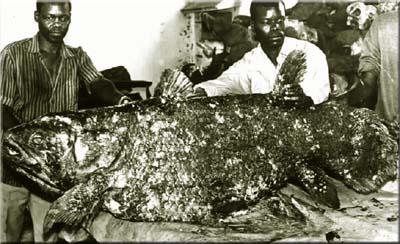
The series continues! Chris Mah and Peter's recent and wonderful posts have goaded me into next segment of the 25 Things You Should Know About The Deep Sea (the last post in this series links to all the previous). The beginnings of deep-sea science in the late 1800's was dominated by two ideas about deep-sea life, the azoic and living fossil hypotheses. The later of these was the abyss sheltered animals through previous extinction events and general catastrophes leading to a repository for fossil taxa. Louis Agassiz and T.H. Huxley, both scientific leaders of the time, were hopeful to find these ancient organisms. Huxley further accepted the existence of "bathybius" a protolife form based on a gelatinous goo that oozed from samples of deep-sea sediment taken by the H.M.S Cyclops in 1857. To honor Ernst Heinrich Haeckel, Huxley named this 'organism' Bathybius haeckelii. The same goo was sampled by the by Challenger expedition, where the chemist J.Y. Buchanan analyzed the material and found no evidence of biological material. Buchanan further demonstrated that Bathybius haekelii was nothing more than calcium sulfate precipitate from when alcohol was added to water. It appeared that Haeckel or Huxley could not get a break.
Despite the death of "bathybius," the fossil hypothesis continued. In 1864, G.O. Sars dredged from 1800ft a crinoid previously only known from the fossil record. Much later in 1938, the hypothesis lived on in the capture of a live coelacanth caught by trawler of South Africa. The coelacanths are a lineage dating some 350 million years and until this discovery thought to have disappeared nearly 25o million years ago. Fast forward to 1952 and the Galathea expedition dredges from 11,878 ft a limpet-like mollusc. Neopilina galathea represent neither clam nor snail but rather a more ancient group called Monoplacophora.
Much later in 1938, the hypothesis lived on in the capture of a live coelacanth caught by trawler of South Africa. The coelacanths are a lineage dating some 350 million years and until this discovery thought to have disappeared nearly 25o million years ago. Fast forward to 1952 and the Galathea expedition dredges from 11,878 ft a limpet-like mollusc. Neopilina galathea represent neither clam nor snail but rather a more ancient group called Monoplacophora.  Another of these deep-sea "fossils" is the Ram's Horn Squid, Spirula spirula, first taken by the Challenger expedition. Spirula represents the lone living specimen of the belemnites, a Mesozoic group that gave rise to the squids and cuttlefish.
Another of these deep-sea "fossils" is the Ram's Horn Squid, Spirula spirula, first taken by the Challenger expedition. Spirula represents the lone living specimen of the belemnites, a Mesozoic group that gave rise to the squids and cuttlefish.  Vampyroteuthis infernalis, another amazing cephalopod from the deep, represents a living member of the Mesoteuthidea from the Cretaceous, a transition group between squids and octopods.
Vampyroteuthis infernalis, another amazing cephalopod from the deep, represents a living member of the Mesoteuthidea from the Cretaceous, a transition group between squids and octopods.
In the words of C.P. Idyll in 1964...
"What is the evidence that the deep sea is a general haven for animals that flourished in very ancient times but withdrew to the abyss because they could not compete successfully in the heavily populated areas near shore?"
Idyll notes that there are "genuine living fossils in the deep sea" and speculating that they maintain their forms from a lack of evolutionary pressure and slow evolutionary rates. Where are we 40 years later? Whereas these 'fossil' forms do indeed exist, much of the deep-sea fauna appears NOT to be a 'living fossil,' which also depends on how 'living fossil' is defined. From McClain et al. (2006)...
The current understanding of the deep sea is that much of its fauna died out in the mid-Cenozoic Era and was replaced by shallow-water immigrants (Gage, 2004). During the period of 30-40 Ma, bottom temperatures throughout much of the deep sea decreased by up to 10 C concurrent with an ocean-wide disoxyia/anoxia event. The mass extinction was followed by a colonization of species from coastal sources. Hypothesized shallow-water origins include polar regions; the Mediterranean Ocean, other regions where the water column is isothermal; or multiple shallow-water areas (Wilson, 1999; Gage, 2004). [For example] Gastropoda, is proposed to have only recently (c. 30 Ma) immigrated to the deep sea from multiple coastal centres (Clarke, 1962). Although...some deep-sea taxa appear to be ancient with high levels of in situ speciation (Wilson, 1999), the predominant direction of migration for many organisms is into deeper water (Jacobs & Lindberg, 1998).
This suggests that many new forms have developed in a relatively short geologic timespan.
Related to the 'living fossil' hypothesis is the number of higher taxonomic groups (Phyla, Class, Order, Family) that are exclusively deep sea (endemics). Besides the ones discussed above, there is the Pogonophora (the beard worms) which contains Riftia from vents, but alas this is fodder for another post...
Guyz: May we have the literature cited in your fascinating post?
The Idyll ref is Abyss the Deep Sea & the Creatures
ISBN:
069001175X
Author:
Idyll, C P
Publisher:
Crowell
Location:
New York :
Publication Date:
c1976
The full ref for McClain et al. 2006 (which has citations for all the other refs. above)
McClain, C.R., A. Boyer, G. Rosenberg (2005) The island rule and the evolution of body size in the deep sea. Journal of Biogeography, 33:1578-1584
You can download it from website http://www.mbari.org/staff/cmcclain/pubs.htm
I was going to guess, "from the Deep Sea, of course", but I guess it's one of those trick questions like "who is buried in Grant's tomb?"